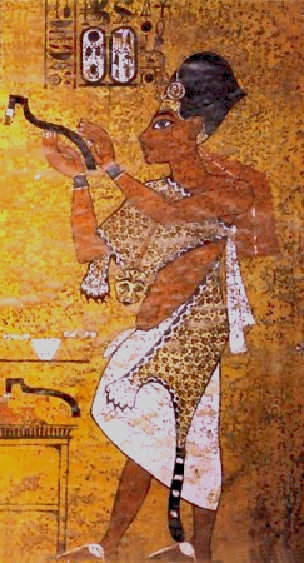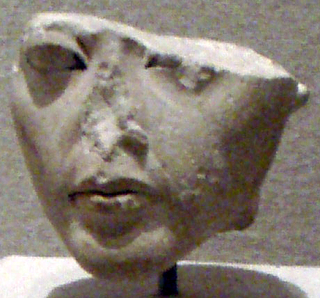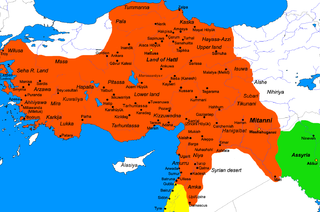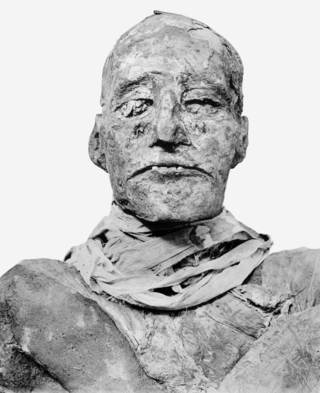Related Research Articles

Tutankhamun or Tutankhamen, was an ancient Egyptian pharaoh who ruled c. 1332 – 1323 BC during the late Eighteenth Dynasty of ancient Egypt. Born Tutankhaten, he was likely a son of Akhenaten, thought to be the KV55 mummy. His mother was identified through DNA testing as The Younger Lady buried in KV35; she was a full sister of her husband.
The 1340s BC is a decade which lasted from 1349 BC to 1340 BC.

Akhenaten, also spelled Akhenaton or Echnaton, was an ancient Egyptian pharaoh reigning c. 1353–1336 or 1351–1334 BC, the tenth ruler of the Eighteenth Dynasty. Before the fifth year of his reign, he was known as Amenhotep IV.

Nefertiti was a queen of the 18th Dynasty of Ancient Egypt, the great royal wife of Pharaoh Akhenaten. Nefertiti and her husband were known for their radical overhaul of state religious policy, in which they promoted the earliest known form of monotheism, Atenism, centered on the sun disc and its direct connection to the royal household. With her husband, she reigned at what was arguably the wealthiest period of ancient Egyptian history. After her husband's death, some scholars believe that Nefertiti ruled briefly as the female king known by the throne name, Neferneferuaten and before the ascension of Tutankhamun, although this identification is a matter of ongoing debate. If Nefertiti did rule as Pharaoh, her reign was marked by the fall of Amarna and relocation of the capital back to the traditional city of Thebes.

Mitanni, earlier called Ḫabigalbat in old Babylonian texts, c. 1600 BC; Hanigalbat or Hani-Rabbat in Assyrian records, or Naharin in Egyptian texts, was a Hurrian-speaking state in northern Syria and southeast Anatolia with Indo-Aryan linguistic and political influences. Since no histories, royal annals or chronicles have yet been found in its excavated sites, knowledge about Mitanni is sparse compared to the other powers in the area, and dependent on what its neighbours commented in their texts.

Horemheb, also spelled Horemhab or Haremhab, was the last pharaoh of the 18th Dynasty of Egypt. He ruled for at least 14 years between 1319 BC and 1292 BC. He had no relation to the preceding royal family other than by marriage to Mutnedjmet, who is thought to have been the daughter of his predecessor, Ay; he is believed to have been of common birth.

Ay was the penultimate pharaoh of ancient Egypt's 18th Dynasty. He held the throne of Egypt for a brief four-year period in the late 14th century BC. Prior to his rule, he was a close advisor to two, and perhaps three, other pharaohs of the dynasty. It is speculated that he was the power behind the throne during child ruler Tutankhamun's reign. His prenomenKheperkheperure means "Everlasting are the Manifestations of Ra", while his nomenAy it-netjer reads as "Ay, Father of the God". Records and monuments that can be clearly attributed to Ay are rare, both because his reign was short and because his successor, Horemheb, instigated a campaign of damnatio memoriae against him and the other pharaohs associated with the unpopular Amarna Period.

The New Kingdom, also referred to as the Egyptian Empire, was the ancient Egyptian nation between the 16th century BC and the 11th century BC. This period of ancient Egyptian history covers the Eighteenth, Nineteenth, and Twentieth Dynasties. Through radiocarbon dating, the establishment of the New Kingdom has been placed between 1570 BC and 1544 BC. The New Kingdom followed the Second Intermediate Period and was succeeded by the Third Intermediate Period. It was the most prosperous time for the Egyptian people and marked the peak of Egypt's power.

Suppiluliuma I or Suppiluliumas I was king of the ancient Hittite kingdom. He garnered recognition within the Hittite kingdom as a great warrior and statesman, notable for successfully challenging the then-dominant Egyptian Empire for control of the lands between the Mediterranean and the Euphrates river. He rose to the throne by overthrowing the kingship of his older brother, Tudhaliya III.

The Amarna letters are an archive, written on clay tablets, primarily consisting of diplomatic correspondence between the Egyptian administration and its representatives in Canaan and Amurru, or neighboring kingdom leaders, during the New Kingdom, spanning a period of no more than thirty years between c. 1360–1332 BC. The letters were found in Upper Egypt at el-Amarna, the modern name for the ancient Egyptian capital of Akhetaten, founded by pharaoh Akhenaten (1350s–1330s BC) during the Eighteenth Dynasty of Egypt.

Ankhesenamun was a queen who lived during the 18th Dynasty of Egypt. Born Ankhesenpaaten, she was the third of six known daughters of the Egyptian Pharaoh Akhenaten and his Great Royal Wife Nefertiti. She became the Great Royal Wife of Tutankhamun. The change in her name reflects the changes in ancient Egyptian religion during her lifetime after her father's death. Her youth is well documented in the ancient reliefs and paintings of the reign of her parents.
Arnuwanda II was a king of the Hittite Empire ca. 1330 BC or 1322–1321 BC. He succeeded his father Suppiluliuma I, who succumbed to the plague which Egyptian captives from his Canaan campaign had brought with them to the Hittite heartland.
The Amarna Period was an era of Egyptian history during the later half of the Eighteenth Dynasty when the royal residence of the pharaoh and his queen was shifted to Akhetaten in what is now Amarna. It was marked by the reign of Amenhotep IV, who changed his name to Akhenaten in order to reflect the dramatic change of Egypt's polytheistic religion into one where the sun disc Aten was worshipped over all other gods. The Egyptian pantheon was restored under Akhenaten's successor, Tutankhamun.

The possible solar eclipse mentioned in a text dating to the reign of Mursili II could be of great importance for the absolute chronology of the Hittite Empire within the chronology of the Ancient Near East. The text records that in the tenth year of Mursili's reign, "the Sun gave a sign", just as the king was about to launch a campaign against the Kingdom of Azzi-Hayasa in north-eastern Anatolia.
Dakhamunzu is the name of an Egyptian queen known from the Hittite annals The Deeds of Suppiluliuma, which were composed by Suppiluliuma I's son Mursili II. The identity of this queen has not yet been established with any degree of certainty and Dakhamunzu has variously been identified as either Nefertiti, Meritaten or Ankhesenamen. The identification of this queen is of importance both for Egyptian chronology and for the reconstruction of events during the late Eighteenth Dynasty.

The Eighteenth Dynasty of Egypt is classified as the first dynasty of the New Kingdom of Egypt, the era in which ancient Egypt achieved the peak of its power. The Eighteenth Dynasty spanned the period from 1550/1549 to 1292 BC. This dynasty is also known as the Thutmoside Dynasty) for the four pharaohs named Thutmose.
Adad-Nirari or Addu-Nirari was a king of Nuhašše in the 14th century BC. His identity and succession order is debated as well as the extent of his kingdom which might have included Qatna. Adad-Nirari engaged in a military struggle again the Hittite king Šuppiluliuma I, asking Egypt for help and invading the kingdom of Ugarit, a Hittite vassal. Those actions prompted Šuppiluliuma to invade the region and relive Ugarit. Adad-Nirari's fate is unknown as he disappeared from records.

The Hittite Plague or Hand of Nergal was an epidemic, possibly of tularemia, which occurred in the mid-to-late 14th century BC.

In ancient Egypt, there is evidence of conspiracies within the royal palace to put the reigning monarch to death. Texts are generally silent on the subject of struggles for influence, but a few historical sources, either indirect or very eloquent, depict a royal family disunited and agitated by petty grudges. Highly polygamous, Pharaoh had numerous concubines living in the harem buildings. At certain points in history, women driven by ambition and jealousy formed cabals ready to sacrifice the general interest for the particular needs of princes and courtiers in need of recognition. In the most serious cases, these factions manifested themselves by fomenting conspiracies that threatened or even shortened the life of the sovereign – all to the hoped-for benefit of a secondary wife and her eldest son in competition with the more legitimate Great Royal Wife.
References
- ↑ "Classroom TUTorials: The Many Names of King Tutankhamun" (PDF). Michael C. Carlos Museum . Archived from the original (PDF) on 19 October 2013. Retrieved 10 July 2013.
- ↑ Suzie Manley. "Ankhesenamun - Queen of Tutankhamun and Daughter of Akhenaten". Egypt * Pyramids * History. Archived from the original on 24 November 2011.
- ↑ Museum Tours - Amarna
- ↑ Eric H. Cline, 1177 B.C.: The Year Civilization Collapsed , p. 70